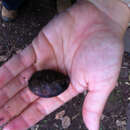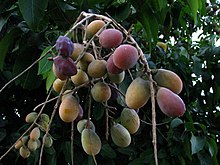zh-TW
在導航的名稱


Sapindus oahuensis is a species of tree in the soapberry family, Sapindaceae. It is endemic to Hawaii, where it is limited to Kauaʻi (Waimea Canyon) and Oʻahu (Waiʻanae and Koʻolau Ranges).[4] Its common names include Āulu,[5] Oahu soapberry, alulu, kaulu, and lonomea.[2]
It can be found in dry and moist forest habitat at elevations of 200 to 2000 feet.[4]
Āulu grows up to 18 m (59 ft) tall with a trunk diameter of 0.5 m (1.6 ft). It has alternately arranged, hairless leaves which have simple blades, unlike its congener, the wingless soapberry (S. saponaria), which has compound leaves. The leaves are somewhat thick and green with a yellow midvein. They are up to 15 centimeters long. The inflorescence is a panicle of many greenish yellow, bell-shaped male and female flowers. The fruit is a shiny, leathery berry roughly 2 centimeters long, containing one large black seed.[5]
The seeds were strung and used in leis.[5]
Sapindus oahuensis is a species of tree in the soapberry family, Sapindaceae. It is endemic to Hawaii, where it is limited to Kauaʻi (Waimea Canyon) and Oʻahu (Waiʻanae and Koʻolau Ranges). Its common names include Āulu, Oahu soapberry, alulu, kaulu, and lonomea.
 Fruits
Fruits It can be found in dry and moist forest habitat at elevations of 200 to 2000 feet.
Āulu grows up to 18 m (59 ft) tall with a trunk diameter of 0.5 m (1.6 ft). It has alternately arranged, hairless leaves which have simple blades, unlike its congener, the wingless soapberry (S. saponaria), which has compound leaves. The leaves are somewhat thick and green with a yellow midvein. They are up to 15 centimeters long. The inflorescence is a panicle of many greenish yellow, bell-shaped male and female flowers. The fruit is a shiny, leathery berry roughly 2 centimeters long, containing one large black seed.
The seeds were strung and used in leis.
Sapindus oahuensis, es una especie de árbol perteneciente a la familia de las sapindáceas que es endémica de las Islas Hawaii. Puede ser encontrada en el bosque seco, costero y bosques mixtos tropicales,[4] a una altitud de 61 a 610 metros[5] en las islas de Kauai y Oahu.[4]
Sapindus oahuensis alcanza un tamaño de 18 m de altura y un tronco de 0,5 m de diámetro.[5] Está amenazada por pérdida de hábitat. Tiene las hojas dispuestas alternativamente, hojas sin pelos y simples, a diferencia de su congénere, Sapindus saponaria, que tiene las hojas compuestas. Las hojas son algo espesas y de color verde con un nervio central amarillo. Miden hasta 15 centímetros de largo. La inflorescencia es una panícula de muchas flores amarillo verdosas, con forma de campana. El fruto es una baya brillante, correosa de aproximadamente 2 centímetros de largo, que contiene una semilla negra grande.[6]
Sapindus oahuensis fue descrita por Hillebr. ex Radlk. y publicado en Elenchus Plantarum Novarum 82. 1838.[7][8]
Sapindus: nombre genérico que deriva de las palabras del latín sap que significa "jabón", e indicus, que significa "de la India ".[9]
oahuensis: epíteto geográfico que alude a su localización en Oahu.
|coauthors= (ayuda) Sapindus oahuensis, es una especie de árbol perteneciente a la familia de las sapindáceas que es endémica de las Islas Hawaii. Puede ser encontrada en el bosque seco, costero y bosques mixtos tropicales, a una altitud de 61 a 610 metros en las islas de Kauai y Oahu.
Sapindus oahuensis ("bồ hòn Oahu"), tiếng Anh thường gọi là Āulu theo ngôn ngữ bản địa hoặc Lonomea, là một loài bồ hòn đặc hữu của Hawaii. Loài này có ở rừng khô nhiệt đới, rừng mưa nhiệt đới ẩm thấp ven biển, và rừng ẩm thấp hỗn hợp của Hawaii[4] ở độ cao 61–610 m (200–2.001 ft)[5] trên hòn đảo Kauaʻi (Waimea Canyon) và Oʻahu (các dãy núi Waiʻanae và Koʻolau).[4] Āulu cao tới 18 m (59 ft) và đường kính thân cây đạt 0,5 m (1,6 ft).[5] Chúng hiện đang bị đe dọa vì mất môi trường sống.
Sapindus oahuensis ("bồ hòn Oahu"), tiếng Anh thường gọi là Āulu theo ngôn ngữ bản địa hoặc Lonomea, là một loài bồ hòn đặc hữu của Hawaii. Loài này có ở rừng khô nhiệt đới, rừng mưa nhiệt đới ẩm thấp ven biển, và rừng ẩm thấp hỗn hợp của Hawaii ở độ cao 61–610 m (200–2.001 ft) trên hòn đảo Kauaʻi (Waimea Canyon) và Oʻahu (các dãy núi Waiʻanae và Koʻolau). Āulu cao tới 18 m (59 ft) và đường kính thân cây đạt 0,5 m (1,6 ft). Chúng hiện đang bị đe dọa vì mất môi trường sống.